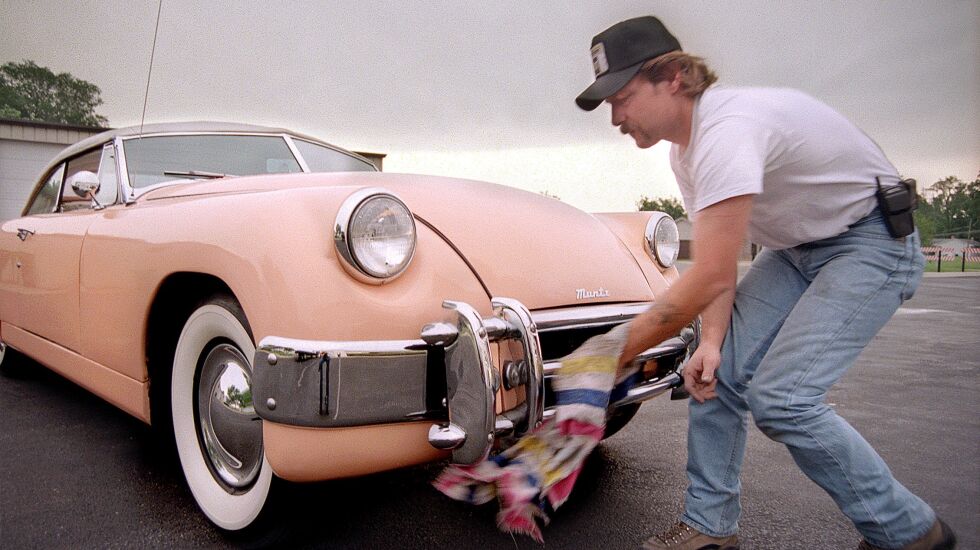
Not many Chicagoans recognize the name George Frost. Typical for a city that shrugs off its technological pioneers. I also imagine most people here, even if they know the atom was first split by human agency on that repurposed squash court under the stands at Stagg Field on the University of Chicago campus in 1942, have no idea which human led the effort (sigh, Enrico Fermi, which will be better known when Columbus Drive is finally named after him, perhaps by the centennial in 2042).
Frost is considered the first person to rig up a car radio, putting one in the door of his Ford Model T, in May 1922, in his capacity as president of the Radio Club at Lane High School.
Somebody was going to do it — cars were all the rage and radio was all the rage, particularly in Chicago. (Ever wonder why the red wagons manufactured here for years were called Radio Flyers? What is “radio” about a kid’s wagon? The answer: Radio was wildly popular, and Antonio Pasin, the Italian immigrant who founded the company, wanted his wagons to be wildly popular, too. The “Flyer” part of the name was a nod to Charles Lindbergh.)
That same year, 1930, that Liberty Coaster changed its name to Radio Flyer, another burgeoning Chicago company, destined also to build an empire based on mobility, Motorola, started selling radios specifically designed to go into cars. Founder Paul Galvin said he came up with the company name while shaving, a mashup of “motor” and “Victrola” (double sigh: a kind of early record player). The ST71 cost $110, and to put that in perspective, the average new car cost $600 in 1930, which means putting in that new Motorola gizmo would be like paying $5,000 for a car’s sound system today.
Those expensive receivers were AM radios. The AM range of the electronic spectrum, from 535 to 1700 kHz, has been popular ever since, as it leads to a stronger signal because the waves don’t skip away out of the Earth’s atmosphere as easily as FM waves. AM reception has an improved signal-to-noise ratio, or less interference.
Interference is what has pushed low-tech old AM radio back into the spotlight recently, as car manufacturers have begun leaving AM out of new cars because the electric motors interfere with the signal. My colleague David Roeder wrote a fascinating front-page story on the issue, including a law being considered in Congress, arguing that AM radio is necessary for national security — to reach people with emergency information — and also outlining Chicago’s rich history as an AM radio center.

As someone who listens to AM radio from the moment he wakes up (Good morning right back at you, WBBM!), I am nevertheless unconcerned about its possible loss in cars. You can always listen via your phone. I understand the argument that car radios are vital in case the whole World Wide Web thing goes kablooey. But not everybody has a car, and given you can buy a new AM/FM portable radio on Amazon for $11, there are easier ways to make sure every household has a radio than to require by law that every new $50,000 electric vehicle includes one.
Besides, given how half the country clutched at itself and collapsed moaning at a few commonsense precautions during COVID, it seems disingenuous in the extreme to demand that channels of government information be kept open, paid for by consumers, who ultimately foot the bill, while training those same consumers to doubt and fear the government and reject whatever they’re told.
Before I let you go, speaking of intersection between cars, technology, law and stuff most people don’t know, the Chicago area boasts the first automobile to include seat belts as a standard feature. It was the Jet, a sports car produced in Evanston, mirabile dictu, by Earl “Madman” Muntz, the used car dealer famed for his Los Angeles billboards showing him in long underwear and a Napoleon hat. The seat belts were included to enhance the Jet’s jet plane image — fighter jet pilots wore safety harnesses — and considered something of a joke.
But the joke caught on, particularly in Illinois, which can be proud that the first seat belt law was passed here, in 1955. About 10% of Americans still don’t wear seat belts. A reminder that it doesn’t matter what you tell people who have methodically trained themselves not to listen.








